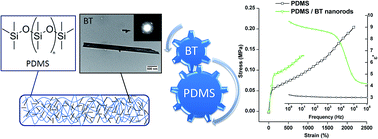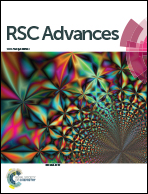Silicone–barium titanate composites with increased electromechanical sensitivity. The effects of the filler morphology†
Abstract
A high molecular weight polydimethylsiloxane-α,ω-diol, synthesized in the lab, was used as a matrix for nanocomposites. Barium titanate nanoparticles, either cubic or nanorods, were obtained by a hydrothermal procedure and used as a filler. In order to ensure a good compatibility with the matrix, the filler was surface treated with a commercial surfactant. A highly reactive trifunctional silane was used as crosslinking agent in the presence of organometallic catalyst. Two other samples, the first consisting of pure crosslinked polydimethylsiloxane and the second being the polymer matrix filled with commercial barium titanate, were prepared and used as references to evaluate the influence of the presence of barium titanate nanoparticles and their shape on some characteristics of the resulting crosslinked composites: morphology, thermal behavior, moisture sorption, mechanical and dielectric characteristics. The electromechanical sensitivity and energy output were calculated on the basis of appropriate experimental data in order to estimate the potential of the composites for future electromechanical applications.


 Please wait while we load your content...
Please wait while we load your content...